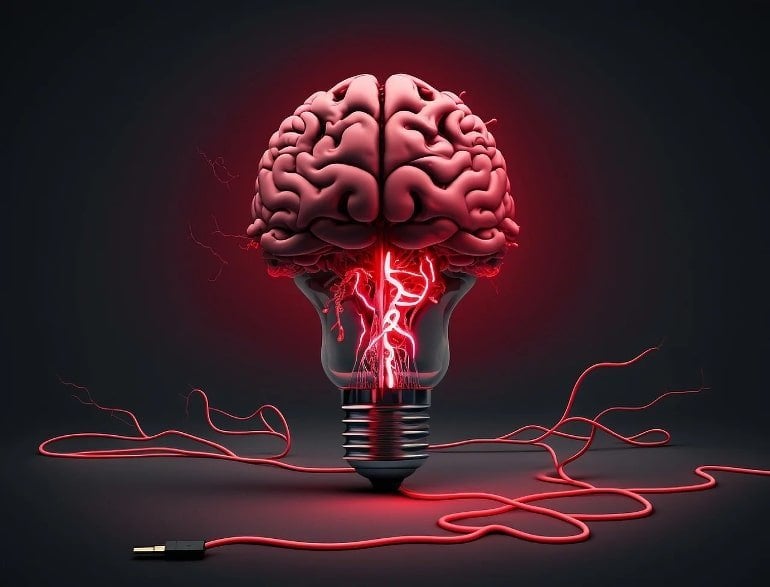Summary: Brain activity can be conditioned through external brain stimulation, researchers discovered. The findings have implications for using TMS as a therapeutic approach, potentially leading to more straightforward treatment for conditions such as Parkinson’s disease and depression.
Source: RUB
Researchers at Ruhr University Bochum, Germany, have successfully implemented a special form of classical conditioning.
They showed in a group of 75 people that the effects of transcranial magnetic stimulation (TMS) can be triggered solely by listening to a tone.
Professor Burkhard Pleger from the Neurology Department at Berufsgenossenschaftliches Universitätsklinikum Bergmannsheil describes the results together with the medical doctoral students Stefan Ewers and Timo Dreier and other colleagues in the journal Scientific Reports, published online on 16 April 2023.
Magnetic stimulation triggers contraction of the thumb muscle
To perform TMS, a magnetic coil is placed externally over a specific part of the brain. The strong magnetic field stimulates the underlying nerve cells to become active.
If a certain area of the motor cortex is stimulated in this way, the index finger or thumb, for example, will move.
For their research, the Bochum-based team used the so-called paired-pulse transcranial magnetic stimulation (TMS).
This involved two TMS stimuli spaced twelve milliseconds apart, which leads to a stronger contraction of a muscle than a single TMS.
In the conditioning phase, the researchers always combined this paired-pulse TMS with a tone that the participants heard via headphones while the TMS was applied.
Conditioned tone intensifies muscle contraction
In the test phase, the participants were no longer exposed to double TMS, but only to a single TMS pulse – paired either with the conditioned tone or with a tone that the participants hadn’t heard before.

At the same time, the researchers once again measured the intensity of the muscle contraction on the thumb: it was significantly stronger when the participants listened to the conditioned tone, as opposed to the tone that they hadn’t heard during conditioning.
Conditioning could be useful for therapeutic applications
“Our basic research proves that traditional conditioning works not only with conscious behaviour patterns,” concludes Burkhard Pleger.
“Brain activity can also be conditioned when manipulated through external brain stimulation.”
This is interesting, because TMS can also be used as a therapeutic approach, for example to improve the mobility of people with Parkinson’s disease or to treat depression.
“Generally, the effects of TMS are only temporary. They disappear if the stimulation is not continued. If these effects could be maintained by conditioned tones, therapy could become much more straightforward,” as Pleger describes one possible benefit of the research.
About this neuroscience research news
Author: Meike Driessen
Source: RUB
Contact: Meike Driessen – RUB
Image: The image is in the public domain
Original Research: Open access.
“Classical conditioning of faciliatory paired-pulse TMS” by Burkhard Pleger et al. Scientific Reports
Abstract
Classical conditioning of faciliatory paired-pulse TMS
In this proof-of-concept study, we questioned whether the influence of TMS on cortical excitability can be applied to classical conditioning. More specifically, we investigated whether the faciliatory influence of paired-pulse TMS on the excitability of the human motor cortex can be transferred to a simultaneously presented auditory stimulus through conditioning.
During the conditioning phase, 75 healthy young participants received 170 faciliatory paired TMS pulses (1st pulse at 95% resting motor threshold, 2nd at 130%, interstimulus interval 12 ms), always presented simultaneously with one out of two acoustic stimuli. In the test phase, 20 min later, we pseudorandomly applied 100 single TMS pulses (at 130% MT), 50 paired with the conditioned tone—50 paired with a control tone.
Using the Wilcoxon-Signed Rank test, we found significantly enhanced median amplitudes of motor evoked potentials (MEPs) paired with the conditioned tone as compared to the control tone, suggesting successful conditioning (p = 0.031, responder rate 55%, small effect size of r = − 0.248).
The same comparison in only those participants with a paired-pulse amplitude < 2 mV in the conditioning phase, increased the responder rate to 61% (n = 38) and effect size to moderate (r = − 0.389). If we considered only those participants with a median paired-pulse amplitude < 1 mV, responder rate increased further to 79% (n = 14) and effect size to r = − 0.727 (i.e., large effect).
These findings suggest increasingly stronger conditioning effects for smaller MEP amplitudes during paired-pulse TMS conditioning. These proof-of-concept findings extend the scope of classical conditioning to faciliatory paired-pulse TMS.







